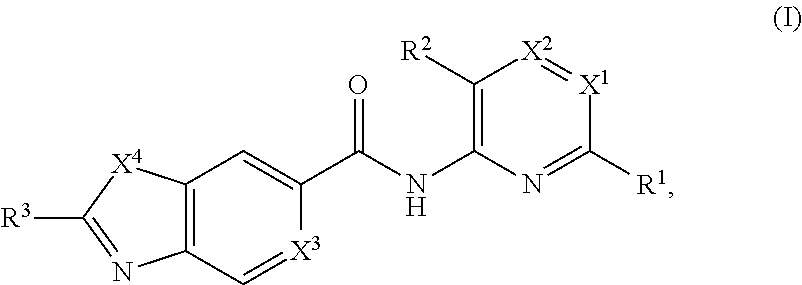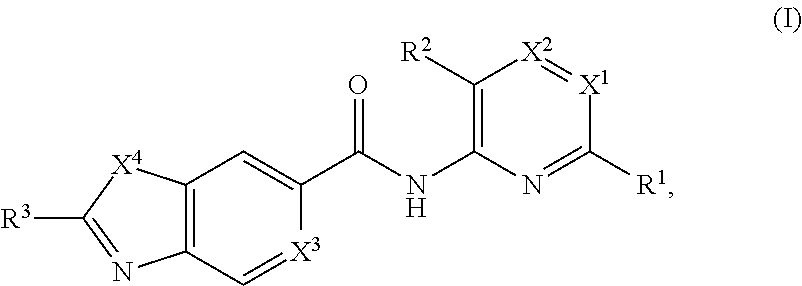Apoptosis signal-regulating kinase 1 inhibitors and methods of use thereof
a signal-regulating kinase and kinase technology, applied in the field of compounds and pharmaceutical compositions useful as ask1 inhibitors, can solve problems such as fat accumulation and fatty acid oxidation, and achieve the effect of prevention or treatmen
- Summary
- Abstract
- Description
- Claims
- Application Information
AI Technical Summary
Benefits of technology
Problems solved by technology
Method used
Image
Examples
example 1
of N-(6-(4-isopropyl-4H-1,2,4-triazol-3-yl)pyridin-2-yl)-1-methyl-1H-benzo[d]imidazole-6-carboxamide
[0203]
Step 1. Synthesis of 1-methyl-1H-benzo[d]imidazole-6-carbonyl Chloride
[0204]
[0205]Oxalyl chloride (42 μL, 0.47 mmol, 1.7 eq) was added dropwise to a mixture of 1-methyl-1H-benzo[d]imidazole-6-carboxylic acid (50 mg, 0.28 mmol, 1.0 eq) and DMF (2 μL, 0.03 mmol, 0.1 eq) in DCM (0.8 mL). The reaction was stirred at rt for 2 hrs. The reaction was concentrated under reduced pressure to give crude 1-methyl-1H-benzo[d]imidazole-6-carbonyl chloride as a yellow residue that was used without further purification.
Step 2. Synthesis of N-(6-(4-isopropyl-4H-1,2,4-triazol-3-yl)pyridin-2-yl)-1-methyl-1H-benzo[d]imidazole-6-carboxamide
[0206]
[0207]A solution of 6-(4-isopropyl-4H-1,2,4-triazol-3-yl)pyridin-2-amine (52.4 mg, 0.26 mmol, 1.0 eq), prepared according to methods disclosed in WO 2016106384, the contents of which are incorporated herein by reference in their entirety, in pyridine (0.68 mL...
example 2
of N-(6-(4-isopropyl-4H-1,2,4-triazol-3-yl)pyridin-2-yl)benzo[d]thiazole-6-carboxamide
[0208]
Step 1. Synthesis of benzo[d]thiazole-6-carbonyl Chloride
[0209]
[0210]Oxalyl chloride (42 μL, 0.47 mmol, 1.7 eq) was added dropwise to a mixture of benzo[d]thiazole-6-carboxylic acid (50 mg, 0.28 mmol, 1.0 eq) and DMF (2 μL, 0.03 mmol, 0.1 eq) in DCM (0.7 mL). The reaction was stirred at rt for 2 hrs. The reaction was concentrated under reduced pressure to give crude benzo[d]thiazole-6-carbonyl chloride as a yellow residue that was used without further purification.
Step 2. Synthesis of N-(6-(4-isopropyl-4H-1,2,4-triazol-3-yl)pyridin-2-yl)benzo[d]thiazole-6-carboxamide
[0211]
[0212]A solution of 6-(4-isopropyl-4H-1,2,4-triazol-3-yl)pyridin-2-amine (51.6 mg, 0.25 mmol, 1.0 eq) in pyridine (0.73 mL) was added to crude benzo[d]thiazole-6-carbonyl chloride (55.1 mg, 0.28 mmol, 1.1 eq) and the reaction was stirred overnight. The reaction was concentrated under reduced pressure. The resultant brown res...
example 6
of 2-(cyclopropylamino)-5-fluoro-N-(6-(4-isopropyl-4H-1,2,4-triazol-3-yl)pyridin-2-yl)benzo[d]thiazole-6-carboxamide
[0213]
Step 1. Synthesis of 2-amino-5-fluorobenzo[d]thiazole-6-carbonitrile
[0214]
[0215]Br2 (5.9 g, 36.9 mmol) was added dropwise to a mixture of 4-amino-2-fluorobenzonitrile (5.0 g, 36.73 mmol), and KSCN (14.3 g, 147.4 mmol) in AcOH (100 mL) at 0° C. The resulting solution was stirred overnight at rt. The resulting mixture was concentrated under reduced pressure. The resultant residue was adjusted to pH˜8-9 with concentrated ammonium hydroxide. The resultant precipitate was collected by filtration and dried in vacuo to give 2-amino-5-fluorobenzo[d]thiazole-6-carbonitrile (6.0 g, 85%) as a yellow solid.
Step 2. Synthesis of 2-chloro-5-fluorobenzo[d]thiazole-6-carbonitrile
[0216]
[0217]CuCl2 (4.2 g, 31.11 mmol) was added to a mixture of isopentyl nitrite (3.6 g, 30.73 mmol), 2-amino-5-fluoro-1,3-benzothiazole-6-carbonitrile (3.0 g, 15.53 mmol) in CH3CN (20 mL) and the result...
PUM
 Login to View More
Login to View More Abstract
Description
Claims
Application Information
 Login to View More
Login to View More - R&D
- Intellectual Property
- Life Sciences
- Materials
- Tech Scout
- Unparalleled Data Quality
- Higher Quality Content
- 60% Fewer Hallucinations
Browse by: Latest US Patents, China's latest patents, Technical Efficacy Thesaurus, Application Domain, Technology Topic, Popular Technical Reports.
© 2025 PatSnap. All rights reserved.Legal|Privacy policy|Modern Slavery Act Transparency Statement|Sitemap|About US| Contact US: help@patsnap.com



